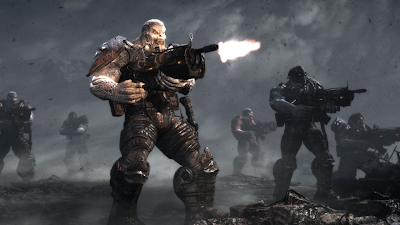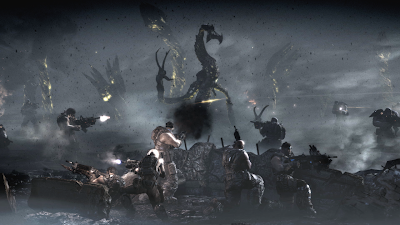Currently there isn’t all that much to go on. Outside of the trailer - which we’ll be analysing in a moment - only a handful of new graphical features and visual effects were mentioned, and of course the intention to further optimise the title for the 360 architecture. However today’s IQGamer report will be just the first of many, and we shall be updating you every step of the way as new information surfaces. It will be interesting to see how the first in-game shots really stack up to Gears 1 & 2, and how many of the cut visual effects from the second game make it back in, if they in fact do so.

In terms of new graphical effects, Epic Games plan to include a global illumination system in Gears 3, along with indirect lighting, an intentional side effect of GI, and increased amounts of particle effects and specular highlighting. Other undisclosed improvements to the overall game engine are also being coded into the latest version of the Unreal Engine 3, mostly in the way of optimisations with regards to existing features found in the tech.
The first of these, a form of global illumination, is a technique in which a single light source reflects and bounces off every surface it comes in contact to. And whilst something that advanced isn’t going to be possible on the 360 in its entirety, a semi-real-time, pre-calculated approach is certainly on the cards.
The second is that as a result of the inclusion of GI, we can expect there to be a lot more in the way of indirect lighting, a side effect from the light bouncing off one source and providing lighting for another. This in turn will create better ambient lighting relying less on pre-baked shadow and light maps, more dynamic in nature, hopefully being done in real-time, of half real, half pre-baked for an effective but cost saving (resource wise) approach.
Both of these effects should go a long way to increasing the sense of depth and realism into the experience, at the same time complementing the use of baked ambient occlusion and shadow maps nicely.

Looking at the trailer itself it’s pretty clear that a few of the new effects, such as indirect lighting and improved specular highlighting are visible. Although there doesn’t appear to be any sign of the GI solution they mentioned.
The trailer seems to be rendered using in-game assets and the actual in-game engine, though it doesn’t appear to have been done in real time. Much like with the first Gears 2 trailer there appears to have a higher image quality compared to both of the first two games, with better texture filtering and less noticeable aliasing. However the trailer also shows off a few low resolution textures and still doesn’t feature a useable MSAA anti-aliasing solution, meaning that in all likelihood it is a genuine in-engine rendered, which could well be matched in the final game. The trailer looks like it’s being rendered in 1080p and downsampled for AA, rather than having actual MSAA for jaggies reduction.
You can also see much greater texture detail as well compared to before. Characters now have facial hair which has a sense of depth about it rather than being just a flat texture. This is done through the use of shader techniques in combination with normal mapping, which seems to also have been improved over Gears 2. Geometry counts looked to have been upped slightly too, which would explain, along with the shaders, how a lot of that extra detail has been included. I would imagine that whilst some elements have less geometry than in previous games, due to better shader usage, other areas of the game would have benefited from a slight increase in order to give more detail.
The use of shadow maps and baked ambient occlusion appears to be present, with the AO looking to be more prominent than before, and the shadow maps creating contrast to parts of the environment not being directly affected by the game’s lighting system.

The above screenshot shows off clearly most of the new graphical effects that were mentioned earlier on. For example there is an abundance of particle effects on screen being kicked up the giant Locust boss character, and everyone from the Gear’s themselves to the standard Locust enemies have more sheen and a smoother look generally provided by better specular and diffuse maps.
Like with Gears 2 the gunfire lights up the environment surrounding the characters, although this time its reach is greater than before, reacting with increased intensity with environmental specular and diffuse maps. In addition the lighting from above the clouds also creates subtle light and dark areas on the ground, encasing characters in shadows and light as the clouds move and pass over them.
Whilst it isn’t possible however, to see any of the indirect lighting that Epic has stated would go into the game, the overall basic lighting and shadowing model has seen noticeable improvement over the first two games. With GI and indirect lighting it should look even better, even though the implementation is likely to be a simple one in order to maintain engine performance.
So far, whilst it looks better than previous the early trailers and tech demos for Gears 2, this Gears 3 trailer only scratches the surface of the improved lighting, although both the particle effects and shaders have seen significant improvements. The GI solution that Epic are working on for the title should make all the difference, and as long as they keep the image quality increases shown in this trailer we should be expecting another technical showcase for the 360.
Well, that’s all we know for now, and everything we can establish from the very short and hardly revealing teaser trailer for the game. Some of the things we pointed out weren’t exactly new to the series, but simply refinements to an existing graphical base of the Unreal Engine 3. As development progresses we expect to see much more in the way of improvements, mainly in the form of the GI lighting, and hopefully a proper anti-aliasing solution as well.
Either way this short little demo already looks to have better tech than in Gears 2, and all that remains to be seen, is how well Epic will do in keeping all the features introduced in forthcoming trailers in the actual final release build of the game.
IQGamer will be following the progress and development of Gears Of War 3 closely, with more tech news and analysis as it breaks.

No comments:
Post a Comment